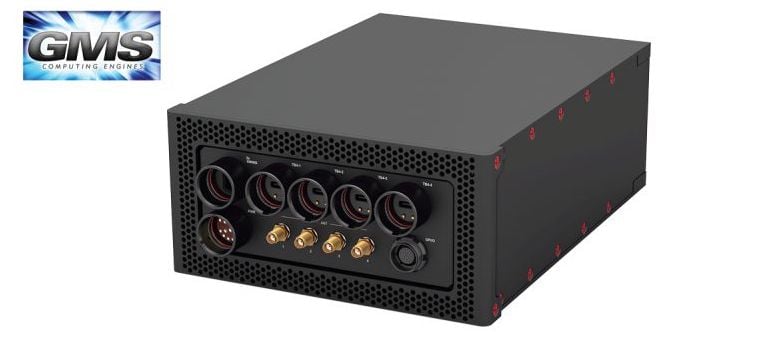
General Micro Systems (GMS) has launched a new, battery-powered wearable computer intended for dismounted soldiers and Marines who require on-the-move high-performance processing, communications, video, database access and Artificial Intelligence (AI).
The ‘X9 Spider Wearable’ S1502-MP mobile computer was designed from the ground up to offer the most compute power and I/O in a small, lightweight battery-powered package.
X9 Spider Wearable can drive up to four on-body displays; connect to wireless LANs and Personal Area Networks (PANs); uplink to mounted assets like vehicles or command posts; store up to 20TB of onboard data, and connect to high-rate body sensors while processing on-board AI algorithms such as image/facial recognition, target tracking or sensor fusion.
Modern warfare is digital, connecting air, sea, ground and US-based assets to soldiers and Marines as never before. A dismounted warrior needs access to the digital battlefield, but also needs wearable, autonomous compute power. A warrior’s modern equipment includes high-resolution range finder, NVIS HMD, smart weapon, moving maps with Blue Force Tracking, ‘buddy display’ for squad members, and on-the-fly voice and facial recognition. These work best with local, on-the-body compute resources since wireless, RF and SATCOM links can be congested, denied or compromised. GMS claims that the X9 Spider Wearable ‘cloud computer’ is the first product to provide this level of battery compute resources to soldiers and Marines in a Manpack (MP) form factor.
Untethered, But Connected Cloud-Like Portable Processing
S1502-MP X9 Spider Wearable is battery powered from common soldier-carried batteries and could bring new capabilities to soldiers and Marines on-the-move. It can free them to receive and process data while on-foot, keeping them connected to the digital battlefield and joint assets without being ‘tethered’ to computers in vehicles or command posts.
With X9 Spider Wearable, the dismounted soldier can receive and process, for example, range-finder data, video scanned via HMD or smart weapon, wireless comms data from over-the-air radio traffic (friendly and enemy), store the data, and process data for display or perform image enhancement for decision making.
Captured data can also be run through on-board AI algorithms on the GPGPU to look for targets, assess patterns, perform voice or facial recognition, or crunch AI and vector mathematics all inside the X9 Spider Wearable with no need to transmit information to reach-back or other computers.
X9 Spider Wearable can give cloud computing capabilities in a BDU pocket, vest, or backpack and can shorten the sensor-to-shooter time loop, increasing lethality and shortening a warrior’s decision-making to instantaneous.
Latest COTS Technology Improved for Rugged Deployment
The wearable computer is based upon Intel’s latest 11th-generation Core i7 Xeon W eight-core (8C Tiger Lake-H) laptop processor, capable of real-time high-resolution 4K video processing to four simultaneous independent displays, plus quad Thunderbolt 4/USB4 40Gbits/s I/O ‘LightBolt’ ports connectable to body sensors.
An optional on-board NVIDIA RTX5000 GPGPU co-processor is closely-coupled to the processor for AI-intensive tasks. Together, the two embedded processors and eight I/O ‘legs’ in the X9 Spider Wearable represent server-class cloud processing in a battery-powered wearable computer that weighs less than three pounds.
The X9 Spider Wearable can be equipped with maximum I/O, including dual 100Gbit Ethernet, four Thunderbolt 4/USB4/LightBolt ports. These connect to on-body high-resolution/high-rate sensors to feed data to Spider Wearable’s CPU and the optional NVIDIA GPGPU AI processor.
“Every ounce in X9 Spider Wearable is carefully planned for ultimate wearable processing,” said Ben Sharfi, CEO and chief architect, GMS. “It’s the perfect balance between CPU and GPU, and between I/O like wireless, Thunderbolt 4 or USB4, which allows designers to buy only what they need.”
The X9 Spider Wearable has patent-pending technology developed exclusively by GMS. An example of GMS innovation in X9 Spider Wearable is LightBolt, a ruggedized fiber optic version of USB4 and Thunderbolt 4. Two complementary industry standards, both Thunderbolt 4 and USB4 use the Type C USB connector, have 40Gbits/s data transfer with video and data, include PCI Express 4.0, and provide 100W Power Delivery.
With LightBolt, these links move data via lightweight and EMI-immune fiber optic cables that neither radiate emissions nor are susceptible to EMI or RFI, adding an element of stealth and security to dismounted soldiers and Marines. And 100W power in LightBolt means that each sensor is connected to and powered directly by X9 Spider Wearable, eliminating the need for batteries or power to each sensor. This simplifies on-body cabling, saves weight and allows faster connect/disconnect when needed.
The inside of X9 Spider Wearable eliminates all cables (except fiber) and relies on patent-pending GMS inter-board connectors that route RF-speed signals—which also reduce weight, minimize EMI, and boost performance. Cooling is provided via GMS’ patented RuggedCool and patent-pending Diamond RuggedCool diamond cooling.
The S1502-MP is one of several technologies GMS will feature at the AUSA Annual Meeting & Exposition in Washington, DC, October 10-12 (booth 8221, Hall DE).












